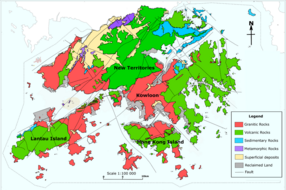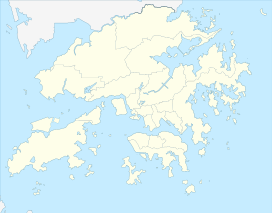Lantau Peak
 From Wikipedia the free encyclopedia
From Wikipedia the free encyclopedia
| Lantau Peak | |
|---|---|
| 鳳凰山 | |
 Lantau Peak rises high above the Tian Tan Buddha. | |
| Highest point | |
| Elevation | 934 m (3,064 ft) |
| Prominence | 934 m (3,064 ft) |
| Coordinates | 22°14′59.17″N 113°55′16.69″E / 22.2497694°N 113.9213028°E |
| Geography | |
| Location | Lantau Island, |
| Lantau Peak | |||||||||||||
|---|---|---|---|---|---|---|---|---|---|---|---|---|---|
| Traditional Chinese | 鳳凰山 | ||||||||||||
| Simplified Chinese | 凤凰山 | ||||||||||||
| |||||||||||||
Lantau Peak or Fung Wong Shan (literally "Phoenix Mountain") is a mountain in Lantau South Country Park, Lantau Island, Hong Kong. It is the second highest peak in Hong Kong and the highest point on Lantau Island, with a height of 934 metres (3,064 ft) above the Hong Kong Principal Datum, or around 933 metres (3,061 ft) above mean sea level.[1][2][3]
Name origin[edit]
The mountain is actually made up of a pair of peaks, one is known as "Fung Shan" (male phoenix mountain) and the other as "Wong Shan" (female phoenix mountain), together they form "Fung Wong Shan".
Location[edit]

Lantau Peak is located within Lantau South Country Park, near the center of Lantau Island, and west of Sunset Peak, which is the second-highest peak on the island. Lantau Peak is reachable by the Lantau Trail. At the foot of Lantau Peak, a tourist spot called the Wisdom Path (心經簡林) can be found.[4]
Geology[edit]
Lantau Peak is formed by Volcanic rocks, including porphyritic rhyolites,[5] like many of the tallest mountains in Hong Kong, such as Tai Mo Shan. Some shorter mountains in Hong Kong are formed by older Granitic rocks.
Lantau Peak is also the source of water for Tung Chung River, a major river on Lantau Island.[6]

Climate[edit]
Lantau Peak is located in central Lantau Island, with an elevation of 934 meters above sea level (23 metres shorter than Tai Mo Shan, Hong Kong's highest peak).[1] Under the Köppen climate classification, Lantau Peak features a subtropical highland climate. Due to its elevation, strong winds and fog occur throughout the year. Winter is cold with temperatures often dipping below 0 °C; summer is warm with temperatures reaching tops of 18-22 °C; spring is cool and humid; autumn is cool and dry. Because there is no weather station at the top of Lantau Peak (934m), the Ngong Ping Weather Station of the Hong Kong Observatory (593m)[7] can be used as reference for the temperature at the summit.
| Climate data for Lantau Peak | |||||||||||||
|---|---|---|---|---|---|---|---|---|---|---|---|---|---|
| Month | Jan | Feb | Mar | Apr | May | Jun | Jul | Aug | Sep | Oct | Nov | Dec | Year |
| Mean daily maximum °C (°F) | 8.3 (46.9) | 10.2 (50.4) | 11.9 (53.4) | 14.2 (57.6) | 16.6 (61.9) | 17.8 (64.0) | 18.5 (65.3) | 19.2 (66.6) | 18.7 (65.7) | 16.6 (61.9) | 13.5 (56.3) | 10.0 (50.0) | 14.6 (58.3) |
| Daily mean °C (°F) | 4.9 (40.8) | 7.2 (45.0) | 9.0 (48.2) | 13.1 (55.6) | 14.8 (58.6) | 16.3 (61.3) | 16.9 (62.4) | 17.1 (62.8) | 16.3 (61.3) | 13.8 (56.8) | 10.6 (51.1) | 6.8 (44.2) | 12.2 (54.0) |
| Mean daily minimum °C (°F) | 2.3 (36.1) | 4.9 (40.8) | 6.8 (44.2) | 10.0 (50.0) | 13.1 (55.6) | 14.7 (58.5) | 15.3 (59.5) | 15.3 (59.5) | 14.5 (58.1) | 11.9 (53.4) | 8.4 (47.1) | 4.2 (39.6) | 10.1 (50.2) |
| Source: Climate Data for Lantau Peak — Hong Kong Observatory | |||||||||||||

See also[edit]
References[edit]
- ^ a b "Lantau South". www.afcd.gov.hk. Retrieved 18 September 2019.
- ^ Lands Department (January 2023). "Hong Kong Geographic Data" (PDF).
- ^ Lands Department (2018). "Explanatory Notes on Geodetic Datums in Hong Kong" (PDF).
- ^ "Tourism Commission - Completed". www.tourism.gov.hk. Retrieved 18 September 2019.
- ^ "Lantau Volcanic Group (undifferentiated) - Jlu". www.cedd.gov.hk. Retrieved 26 April 2020.
- ^ "JC WISE - Rivers@HK Database | Faculty of Social Sciences, HKU". www.jcwise.hk. Retrieved 15 April 2021.
- ^ "Variation of Wind Direction and Speed". www.hko.gov.hk. Retrieved 18 September 2019.
